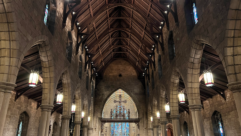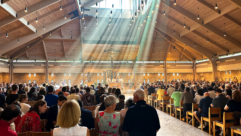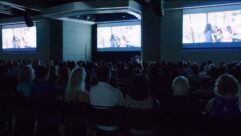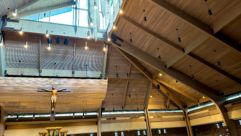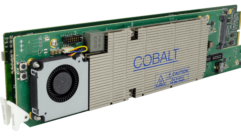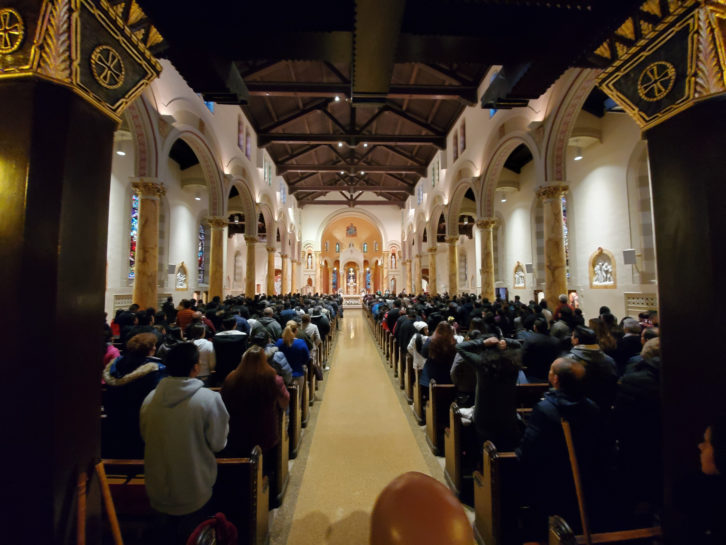 On this edition of the SVC Podcast, Contributing Editor Bennett Liles completes his discussion with Steve Minozzi of Monte Brothers Sound Systems in New York regarding the complete sound upgrade at the huge St. Bartholomew’s Church in Elmhurst. Steve discusses acoustics and system setup including balancing levels and configuring the Biamp controller for best gain before feedback in the highly reverberant church.
On this edition of the SVC Podcast, Contributing Editor Bennett Liles completes his discussion with Steve Minozzi of Monte Brothers Sound Systems in New York regarding the complete sound upgrade at the huge St. Bartholomew’s Church in Elmhurst. Steve discusses acoustics and system setup including balancing levels and configuring the Biamp controller for best gain before feedback in the highly reverberant church.
FOR MORE: GO TO PART 1
- Terraspeakers CAMM DT-400 two-way speakers
- Audio-Technica ATW-AT410P wireless mic antennas
- Audix MB-8455 MicroBoom microphones
- Biamp TesiraFORTE AVB-AI DSP processor
- Monte Brothers Sound Systems
Getting clear speech on the sound system of a huge cathedral style church is no easy task but at St. Bartholomew’s Church in Elmhurst, New York the layout makes it even tougher. Monte Brothers had to use some special techniques and a combination speaker system to make it all work. Steve Minozzi is back with the rest of the story for us coming up on the SVC Podcast.
Steve it’s good to have you here on the SVC Podcast from Monte Brothers Sound Systems in New York. Thanks for getting back with us.
Good to be back.
We’ve been talking about St. Bartholomew’s Church in Elmhurst, New York and the big job you had there getting speech clarity in an especially tough acoustic environment. What sort of timeline did you have to run new speaker wiring and get this whole system working? What were the steps?
Well, we do it two ways. On a big project like this we have, at this time, close to a million dollars’ worth of these sitting out there. Some of them are renovations, some of them are new construction, and some of them are what we call retrofit; meaning that everything is there, we don’t have to deal with other tradespeople. And St. Bartholomew’s we’ll call a retrofit, which means it’s accessible to us from day one. We don’t have to wait about for construction schedules. So the policy we usually follow, because there’s always what you call Murphy’s Law. How do you get the wire in these magnificent buildings that have solid stone walls and foot-thick flooring? How do you get the wire from Point A to Point B? So the typical way we do it is we create the package for the new system, which has floor plans, schematics, photos, labeled photos. Then we do what we call scoping. We send out a crew of our top mechanics. They go through the whole space and evaluate how we would get the wire from Point A to Point B. Once we’ve established how we’re going to do it, then we advise the owner this is how we’re going to do it. If it’s going to be more difficult than we thought then we say to the owner we may do this in stages. We may begin the cable installation without interrupting your sound system which may happen over a two-week period where we send mechanics in and they install the cable. That has to go where it has to go so you may see cables here or there. Usually the owner is fine with that. Once we’ve got that under control and we know that we have a way to get cable everywhere, even if we haven’t done it yet, then we bring in an enhanced crew of technicians. We work with a lot of local electricians that have low voltage that supplement our workforce if necessary. And that does happen quite often, but it’s always in conjunction with our technicians and mechanics. Once we do that we know we have it under control, then we advise the owner that we’re going to come in on a Monday with a full crew. At that point you may not have a sound system functioning completely until maybe Wednesday but you will have a new system by the end of the week. That being said, then we continue to install the system. At the end of the week we have a technician that comes in on the weekend and works with the staff and the clergy and fine tunes the system because we have total control of it from the actual worship space with our computers. And that’s usually the process we follow when we do a sound system. So the actual installation you could say happens in a week, but in the case of St. Bartholomew’s as an example, it was what they call a scoping where we were there probably two weeks earlier to evaluate because of the ornateness of the building and the way the structure was constructed, how we were going to do it and maybe some preliminary cable. [Timestamp: 4:03]
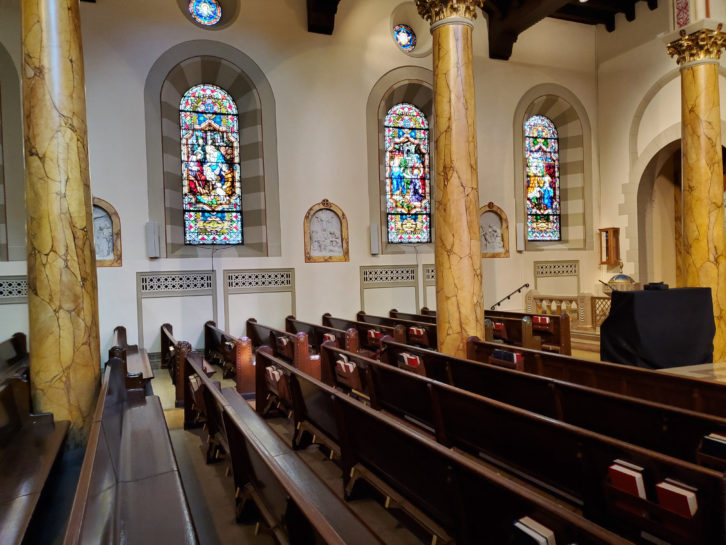
And I believe you used the CAMM line of speakers, several different models.
Right. I believe they’re owned by Leon now, but it’s still the CAMM and they also have a brand called Terra, which we do use on outside sound. And the reason we use the CAMM is we helped develop that technology, that Ferrofluid technology where the voice floats on electromagnetic Ferrofluid. Back in 1999 when it was owned originally it was called NEAR, New England Audio Resource. So we’ve been working with these people for 20 years. Basically the importance with speakers is that – two things. In a house of worship they have to cosmetically acceptable to the owner. And that being said, a lot of speaker companies don’t do that. CAMM will actually screen the grill cloths and make them any color you want. As a matter of fact, I was watching that show – the New York City Commissioner? Blue Bloods. We were watching that last night. I have it recorded. And the woman was in church. And that was St. Patrick’s old cathedral basilica on Mulberry Street in New York City, which has the CAMM speakers in it that have been cosmetically treated on the columns and on the walls in such a case that the producers didn’t even remove the speakers for the scenes. They left them up. So between the ability for consistency that models don’t get discontinued and the fact that they’re willing to cosmetically treat the speaker so to blends in, and of course it has a good sound. There are many good speaker companies. They’re all good. I mean it’s like BMW, Mercedes, Cadillac. It doesn’t matter. They’re all good at what they do. It’s just this is a step more in the direction of cosmetics and performance. So that’s pretty much why we stay with them. And we do have a voice. Before they drop a line we need to know this because as you can see from this diagram I sent you, if any of these speakers are discontinued in five years and there’s water damage or electrical storm damage to some of these devices, how do we replace them? We’d have to change all of that model speaker. That’s an extreme cost to the owner. I think that would be a very unpleasant experience for the owner. And that’s why we use that company. We pretty much stay with the companies that work with us. Again it’s not that they’re necessarily heads above anyone else. All the speaker companies are good. Community, we use them occasionally for different projects. They’re all good. It’s just which one is able to give us the attention we need to deal with spaces that look like this space, which are very cosmetically challenging. [Timestamp: 6:49]

St. Bartholomew’s, that place is so huge. Does it sound a lot different when you have it full of people than it does when it’s empty?
Yes. And it does not have pew cushions, which we highly recommend in houses of worship. But that’s an issue that’s political and whatever and we’ll deal with that on another day. But the difference typically in a worship space like this, that size space would probably have about 4,000-4,500 square feet of absorption in it. In essence it has none. No absorption. The only assets it has is some of the – the fact that the ceiling is a little lower on the side aisles of the nave helps somewhat. But yes, what happens in that church is the acoustic profile changes by almost 70 percent from completely empty to completely full. When you have pew cushions or upholstered pews, it only changes about 20-25 percent. That being said, how do we deal with it? Well, that’s where the DSP processor comes in. It creates a dynamic range and we have ways of programming those processes. It doesn’t matter what company. They all have this capability if it’s open-end architecture, which many of the DSP processor companies have. But we’re able to program them in such a way that it’s almost like artificial intelligence. Like you had an engineer there saying okay, we don’t want the low frequency levels to rise past this many dB in a specific speaker enclosure. And that’s how we do it because we can’t do it with absorption. There’s nowhere to put the absorption. And if you put absorption in a house of worship like this – let’s just say you put carpet on the floors and panels on the walls. What’s going to happen is when you put the people in – this church seats about a thousand people. That’s automatically 2,000 square feet of absorption by putting people in the pews. If you take the people out of the pews and you have upholstered pews, you still have 2,000 square feet of absorption. If you have the people in the pews that “people’ 2,000 square feet of absorption is noncumulative because they’re sitting on the other absorption. So we do it with technology. There’s nowhere to put absorption here. So that makes these churches more difficult than buildings. What you have to do with the sound for the owner to say, “I don’t want to do anything. I just want to turn it on and use it.” No? Then we’ve got to do something. So we do it with technology that we’ve developed over this many years. And it works. [Timestamp: 9:20]
Yes, I would think that one of the challenges here was the fact that the choir appears to be located way back up in the rear balcony. How do they hear the pastor and the organ?
The speaker zones that we install, like the speakers that are in the choir loft, it’s like having a separate sound system. Those speakers in the choir loft only amplify the microphones in the sanctuary or microphones that are not in the choir loft. Therefore you don’t get phase cancellation and acoustic feedback from microphones coming out of speakers that are in their vicinity. [Timestamp: 9:51]
OK, sort of a mix-minus arrangement.
It is, yes. But it’s – again, it’s done automatically. And then of course if you have people performing in the left transept that microphone doesn’t necessarily get replicated from the speaker that’s right next to it. If you’re going through the right transept that microphone is not amplified by the speaker that’s next to it because you don’t need it and it’s going to create a problem. But that’s all automatic. It’s done by the management for the DSP processors. And this is how you get the system to work automatically because I don’t know how else you would do it. You’d have to have a full-time engineer and if he got sick what would you have for the service? [Timestamp: 10:31]
Yes, and another one of the difficult things is once you have all of this up and running, how did you balance levels and test everything?
We have to balance it under the worst case scenario, which his empty. Which is easy because it’s empty. And as we said, there’s a 70 percent change in acoustics so what we do is after the system is in we have a technician attend the weekend services, Saturday and Sunday, with a computer. And he literally recalibrates whatever has to be done with the attendance there, and there are different levels of attendance on weekends. Some services only get a quarter full, some get full, and we’re able to calibrate the system under those conditions. So it’s like a custom-made suit. There’s no cookie cutter for this. You need to have people in the space adjusting it accordingly. [Timestamp: 11:19
Yeah, one size does not fit all on those.
No, no. There’s no cookie cutter here. I know a lot of people use those acoustical profile programs that try to tell you what the acoustics are. We don’t really need that because we know what the acoustics are. We can go into the space and calibrate it. [Timestamp: 11:37]
And when you’re doing that is there a specific frequency range that you find in these layouts that’s most prone to feedback?
Well feedback, that depends on what mics you’re using, what speakers you’re using, where the mics are in relation to the speakers. So feedback cycles typically are affected by that. Frequencies, or what you call the tendencies of worship spaces that look like this, typically have very, very active acoustics in the mid-range and low frequencies; so from, say, 180 Hz to about 800 Hz we have a lot of activity. And that absolutely affects intelligibility. [Timestamp: 12:19]
That’s a lot to handle and I know that you only had a specific time to get it all done but it looks like you pulled it off just fine. So what’s coming up next for Monte Brothers? What sort of projects do you have up now?
Well, we have a lot of them. Some of them are renovations, which we have coming up, that have their own challenges. And so we have to keep moving them around so that we can comply with the schedules and then proceed with the projects. We are doing one in Virginia that’s incredibly challenging and I think you would be very impressed with the size, the logistics. It’s not a traditional space, it’s a more modern space. But it has acoustics that are actually more challenging even than St. Bartholomew in Elmhurst. [Timestamp: 13:03]
Lots to keep up with and I know you’re glad to have this one done and you can make any needed tweaks remotely. That’s always a great thing. Thanks for taking time out to tell us about it. We’ve been talking with Steve Minozzi of Monte Brothers Sound Systems in New York about the St. Bartholomew’s Church in Elmhurst. Sound like you guys went in there and did a thorough job and I’m sure they love the new sound system they have now.
I believe the owner is extremely happy, the pastor. [Timestamp: 13:32]
Appreciate your being with us today, Steve. Thanks very much.
Take care.
St. Bartholomew’s Church has the sound it needs, the simple control and the 24/7 support from Monte Brothers to keep clear sound coming to their parishioners every time. We’ve got more AV installation case studies so get back with us for another one on the next SVC Podcast.


